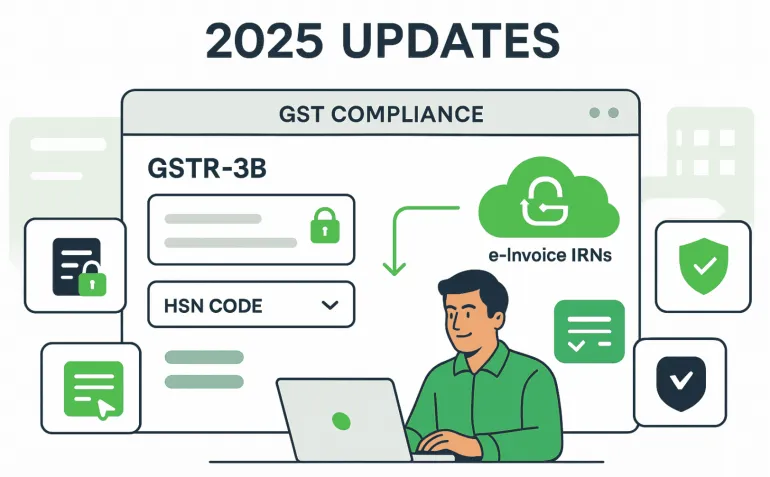Recent GST Updates - Recent GSTN Advisories
Advisory on reporting values in Table 3.2 of GSTR-3B
Apr 11th, 2025 (Reference from here)
1. Of the supplies reported in Tables 3.1 and 3.1.1 of GSTR-3B, interstate supplies made to composition taxpayers, unregistered people, and UIN holders are recorded in Table 3.2 of Form GSTR-3B. The equivalent interstate supplies reported in GSTR-1, GSTR-1A, and IFF in the necessary tables are the source of the figures in Table 3.2 of GSTR-3B.
2. This is to notify you that interstate supplies that are automatically entered in Table 3.2 of GSTR-3B will no longer be editable as of the April 2025 tax year. Only the system-generated auto-populated values should be submitted on the GSTR-3B.
3. As a result, the only way to change the auto-populated values in Table 3.2 of GSTR-3B is to change the corresponding values in the relevant tables of GSTR-1A or by filing Form GSTR-1/IFF for later tax years.
4. It is recommended to record the proper values in GSTR-1, GSTR-1A, or IFF in order to make sure that GSTR-3B is reported appropriately with the correct values of interstate supplies. This will guarantee that the automatically generated values in GSTR-3B's Table 3.2 are correct and adhere to GST laws.
Advisory on Table-12 of GSTR-1 or GSTR-1A
Apr 11th, 2025
This is to notify you that GSTN has made phased modifications to GSTR-1 or GSTR-1A Table-12.
Numerous advisories have been periodically released on the same, and they may be found on the GST Portal.
Phase III of Table 12 of GSTR 1 & 1A will be implemented by GSTN starting with the April 2025 tax period. which suggests:
(1) To report these supplies' HSN-wise summaries separately in the appropriate table, Table 12 has been divided into two tables, B2B and B2C.
(2) HSN entry by hand will not be permitted. The taxpayer can select the appropriate HSN from the provided drop-down menu.
Please refer to the GSTN advice dated January 22, 2025, available on the GST Portal for thorough assistance on the previously mentioned subject here.
Advisory on Case Insensitivity in IRN Generation
Apr 4th, 2025
Dear Taxpayer,
1. This is to inform you that, effective 1st June 2025, the IRP (Invoice Reporting Portal) will treat invoice/document numbers as case-insensitive for the purpose of IRN generation.
2. To ensure consistency and avoid duplication, invoice numbers reported in any format (e.g., "abc", "ABC", or "Abc") would be automatically converted to uppercase before IRN generation. This change aligns with the treatment of invoice numbers in GSTR-1, which already treats them as case-insensitive.
3. The same is shared for your kind information, please. For any further clarification, please reach out to the GST helpdesk.
Advisory on E-Way Bill Generation for Goods under Chapter 71
Feb 6th, 2025
Subject: Clarification on E-Way Bill Requirement for Goods under Chapter 71
According to Rule 138(14) of the Central Goods and Services Tax (CGST) Rules, 2017, as well as its Annexures S.Nos. 4 and 5, there is no need to create an E-Way Bill for items covered under Chapter 71, such as natural or cultured pearls, precious or semi-precious stones, jewelry, jewelry clad in precious metal, and items made by goldsmiths or silversmiths, with the exception of those categorized under HSN 7117 (Imitation Jewellery).
The National Informatics Centre (NIC) has made it possible to create EWBs for goods covered under Chapter 71, with the exception of HSN 7117 (Imitation Jewellery), under the category "EWB for Gold" on the EWB portal. This is in response to the introduction of the E-Way Bill (EWB) for goods classified under Chapter 71 in the state of Kerala for intrastate movement.
The availability of this option in the EWB system has led to the voluntary generation of EWBs for items under Chapter 71 by a number of industry partners. In this context, it is made clear that although the system formerly permitted EWB creation for items under Chapter 71, this feature has since been removed.
Therefore, it is indicated that EWB generation is not necessary for taxpayers and carriers involved in the movement of products under Chapter 71 (except for HSN 7117). However, it should be noted that the state of Kerala's Notification No.10/24-State Tax, dated 27/12/24 requires the creation of an EWB for the intrastate transportation of such items within the state. In this context, an advice dated January 27, 2025, has already been released.
It is asked that industry stakeholders pay attention to this clarification and make sure that the relevant regulatory rules are followed.
Stakeholders should seek their local jurisdictional tax authorities or get in touch with the GST Helpdesk for any additional explanations.
Attention – Hard Locking of Auto-Populated Liability in GSTR-3B
Jan 27th, 2025
1. Regarding the restriction on amending the auto-populated obligation in GSTR-3B from the January 2025 tax period, please refer to the advice of October 17, 2024.
2. Nonetheless, the trade has made a number of requests for time for the same. Therefore, starting with the January tax period, the GST Portal is not implementing the decision to make the auto-populated obligation in GSTR-3B non-editable.
3. Please be advised that trade will be informed as soon as the previously mentioned alteration is put into effect. Taxpayers are encouraged to prepare for the previously indicated modification.
Advisory on Business Continuity for e-Invoice and e-Waybill Systems
Jan 24th, 2025
Dear Taxpayers,
This advice is to draw attention to the backup plans and other methods available for the e-Waybill and e-Invoice systems.
If you haven't added these alternatives to your current systems or aren't using them yet, GSTN suggests collaborating with your system integrators, IRPs, ERPs, GSPs, or ASPs to enable them. By doing this, it would be ensured that these systems are fully operational and accessible when needed.
Multiple IRPs for e-Invoice Reporting
To provide redundancy and ensure continuity, six Invoice Registration Portals (IRPs) are operational:
1. NIC-IRP 1
2. NIC-IRP 2
3. Cygnet IRP
4. Clear IRP
5. EY IRP
6. IRIS IRP
Interoperability between the NIC-IRP 1 and 2 portals enables a smooth transition between them in the event of a service interruption.
These features may be tested in the NIC sandbox environment that can be accessed at here.
Additionally, any of the other e-invoice IRPs mentioned above might be utilized in the event that NIC-IRP is unavailable.
Dual Portals for e-Waybill Services
Similar redundancy is provided for e-waybill operations with two portals:
1. eWaybill 1
2. eWaybill 2
Unified Authentication Token at NIC-IRP & e-Waybill Portal
A single authentication token can be produced using any one of the NIC-IRP e-Invoice1 & e-Invoice2 and NIC: e-Waybill1 & e-Waybill2.
Once generated, this token is valid across all NIC portals, eliminating the need for separate tokens for each platform.
API Interoperability for Seamless Operations
By setting up their systems or making sure it is done with the appropriate solution provider, taxpayers who use APIs can benefit from cross-portal operations:
i. Accessing NIC1 e-Invoice Services via NIC2 APIs: By passing the "NIC1" value in the "irp" API header for APIs at https://api.einvoice2.gst.gov.in
ii. Accessing NIC2 e-Invoice Services via NIC1 APIs: By passing the "NIC2" value in the "irp" API header for APIs at https://api.einvoice1.gst.gov.in
iii. Supported e-invoice APIs for cross-operation:
a. Get IRN Details
b. Cancel IRN
c. Get IRN Details by Doc. Details
d. Generate e-Waybill by IRN
e. Get e-Waybill details by IRN
IV. For e-waybill cross-operation, currently
1) Get e-way bill details &
2) Part B update APIs are available to be used interoperably via this link and this.
Actions Recommended for the Taxpayer
1. Direct API Access: Verify that your systems support cross-portal interoperability for seamless service access.
2. Coordination with Service Providers: Engage with your IRP, ERPs, GSPs, or ASPs to ensure alternate mechanisms are enabled and fully integrated into your systems.
3. Explore Additional IRPs: In addition to NIC-IRP 1 & 2, other IRPs are also available for use.
The purpose of this advice is to make sure that taxpayers have access to the backup they need to continue operating normally in the event of a service interruption.
For further assistance, please contact your system integrators, service providers, or the GST helpdesk. More details are available at the respective IRPs and e-waybill portal.
Implementation of Mandatory Mentioning of HSN Codes in GSTR-1 & GSTR-1A
Jan 22nd, 2025
After the successful implementation of Phase-I & Phase-II, now Phase III regarding Table 12 of GSTR-1 & 1A will be implemented soon. In this phase, manual entry of HSN has been replaced by choosing the correct HSN from the given drop-down.
Additionally, Table 12 has been divided into two tabs, B2B and B2C, in order to report these suppliers independently. Additionally, for both of Table 12's tabs, validation has been included with respect to the values of the supplies and tax amounts involved.
However, in the initial period, these validations have been kept in warning mode only, which means failing the validation will not be a blocker for filling out GSTR-1 & 1A. To view the detailed advisory, please click here.

